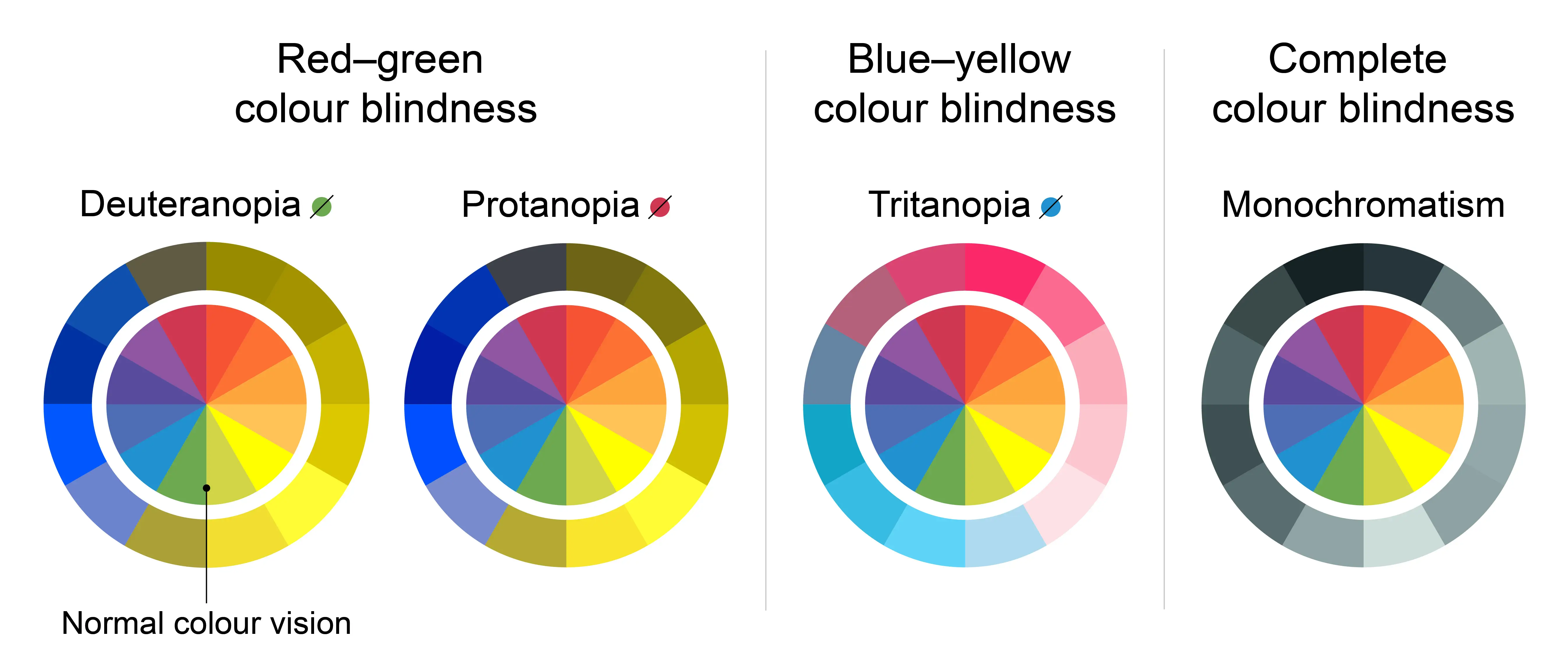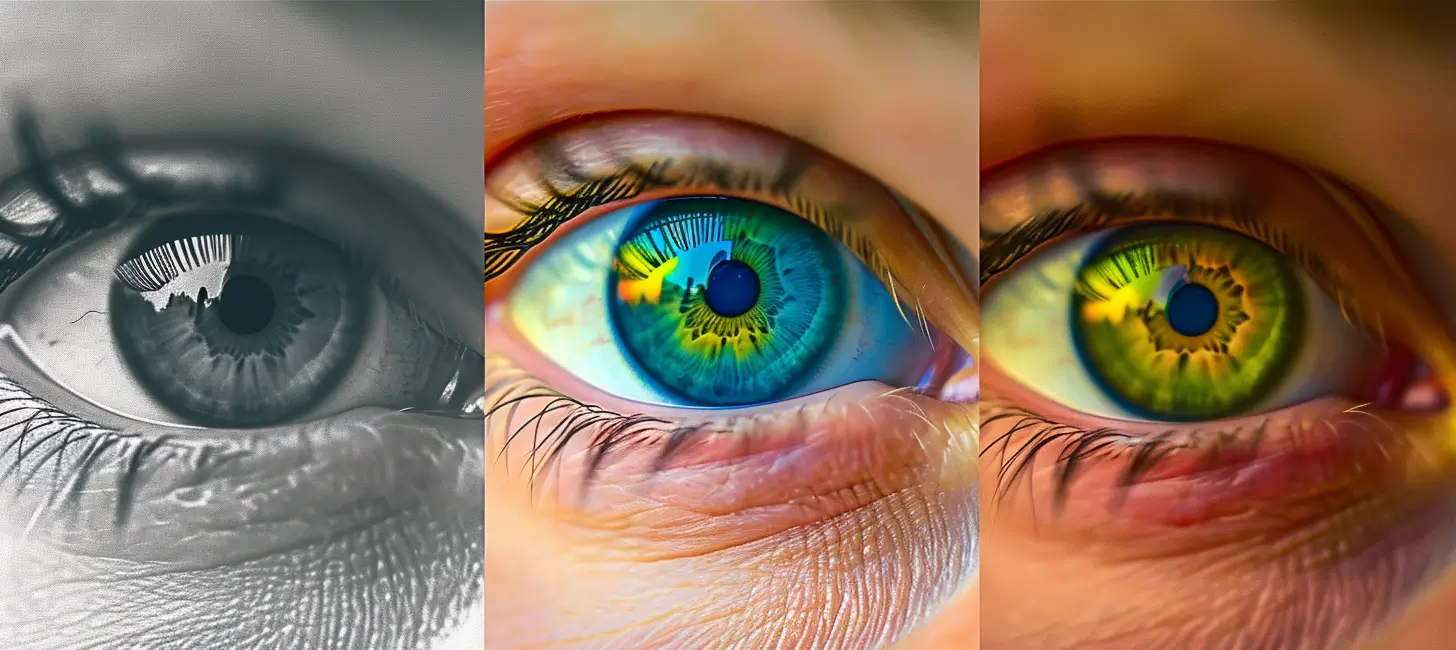Understanding Color Blindness: Types, Causes, and Life Adjustments
2024-01-23 | By Orcam Staff

Color blindness often goes unnoticed, yet it profoundly affects millions of lives around the globe. At its core, being color blind means experiencing the world in a palette that differs significantly from the norm. This condition isn't just about mixing up reds and greens; it's about navigating daily challenges, understanding the underlying causes, and finding ways to adapt. With advancements in technology, like those developed by OrCam, individuals with color blindness can now experience a richer perception of their environment, empowering them to live more vibrant lives.
What Is Color Blindness?
Color blindness, or color vision deficiency, is a condition where a person's ability to see colors and their nuances is different from what most of us perceive. This isn't a form of blindness at all, but rather a deficiency that changes how colors are seen and distinguished. The term encompasses a variety of types and severities, affecting individuals in unique ways.
The Science Behind Seeing Colors
To understand color blindness, it's essential to grasp how we see colors. The human eye contains photoreceptors known as cones and rods. Cones are responsible for color vision and are predominantly sensitive to red, green, or blue light. When one or more types of these cones are absent, underperforming, or perceiving colors differently, color blindness occurs. It's a fascinating interplay of genetics and biology, shedding light on why certain colors blend into each other for some people.
Types of Color Blindness

Understanding the different types of color blindness is crucial for recognizing the diverse experiences of those affected by this condition. Each type has its unique challenges and impacts on perception.
Red-Green Color Blindness
The most common form of color blindness is red-green color blindness, which includes two main types: Protanopia and Deuteranopia. Individuals with Protanopia have difficulty distinguishing between red and green hues because their eyes are less sensitive to red light. On the other hand, those with Deuteranopia see green colors as more red, leading to confusion between the two. This type of color blindness can make it challenging to interpret traffic lights, choose ripe fruits, or select clothing.
Blue-Yellow Color Blindness (Tritanopia)
Tritanopia is less common and involves difficulty distinguishing between blue and yellow hues. People with this condition might confuse blues with greens and yellows with violets. Imagine looking at a field of green grass under a bright sky and seeing it all as a somewhat muddy, indistinct hue. That's the reality for someone with Tritanopia.
Complete Color Blindness (Monochromacy)
The rarest form, monochromacy, or total color blindness, means seeing the world in shades of gray. This condition results from the absence of functioning cone cells in the retina. For those with monochromacy, the world lacks color altogether, resembling an old black and white photograph.
Causes of Color Blindness
Diving into the causes of color blindness opens up a dialogue about its complexity and the factors that contribute to its development.
Genetics of Color Blindness
The primary cause of color blindness is genetics. The genes responsible for this condition are usually passed down from parents to their children on the X chromosome, explaining why color blindness is more common in males than females. If a mother carries the gene for color blindness, her son has a significant chance of being color blind.
Environmental Factors and Health Conditions
Beyond genetics, certain environmental factors and health conditions can also lead to color vision deficiency. Diseases affecting the retina or optic nerve, such as glaucoma or macular degeneration, and exposure to certain chemicals can alter color perception. This aspect highlights the importance of regular eye examinations for maintaining optimal vision health.
OrCam recognizes the diverse needs of individuals with vision impairments, including color blindness. Through innovative technology, OrCam seeks to enhance the daily lives of those navigating the challenges of color vision deficiency, offering tools that adapt the world to their unique vision, rather than the other way around. By understanding and addressing the varied types and causes of color blindness, we can better support our friends, family, and community members in experiencing the world more fully.
Diagnosing Color Blindness
Early detection and diagnosis of color blindness can make a significant difference in how individuals adapt to their condition. Understanding the diagnostic process helps demystify color blindness and empowers people to seek solutions and support.
Common Tests for Color Blindness
The most well-known test for diagnosing color blindness is the Ishihara test, which consists of a series of colored dot patterns forming numbers or shapes that can only be distinguished if certain color vision capabilities are present. Other diagnostic tools include the Anomaloscope, which measures the extent of red-green color vision deficiency, and newer digital tests that offer more nuanced insights into how individuals perceive color. These tests are simple, non-invasive, and provide immediate results, making them accessible options for identifying color vision deficiencies.
When to Seek a Diagnosis
Individuals might consider seeking a diagnosis if they frequently confuse colors that others can easily distinguish, struggle with tasks that require color discrimination, or if there's a family history of color blindness. Early diagnosis in children is particularly important as it can affect learning and social development. Knowing about the condition early on allows for the implementation of strategies and tools that can mitigate these challenges.
Everyday Impacts and Managing Color Blindness
Living with color blindness means navigating a world designed primarily for those with full color vision. However, understanding its impacts and learning to manage the condition can significantly enhance quality of life.
Challenges in Daily Activities
Color blindness can affect various aspects of daily life, from reading traffic lights to choosing matching clothes or determining the ripeness of fruits. Educational settings and certain professions may also pose challenges, as color coding is often used for important information. Recognizing these challenges is the first step towards finding effective coping strategies.
Tools and Technologies for Assistance
Technology has opened up new possibilities for assisting those with color blindness. OrCam, for example, develops devices that provide auditory descriptions of visual information, which can be particularly helpful in environments where color plays a critical role. Additionally, color identification apps, color-corrective glasses, and software that adjusts computer and smartphone displays to accommodate color vision deficiencies are invaluable tools that can transform how color-blind individuals interact with their environment.
Designing for Inclusivity
Awareness and consideration of color blindness in design can lead to more inclusive environments and digital experiences. Using patterns, textures, and contrasting colors instead of relying solely on color differences can make information accessible to everyone. Advocating for inclusivity in design not only benefits those with color blindness but also enhances usability for a broader audience.
Supporting Someone with Color Blindness
Support from family, friends, and educators is vital in helping those with color blindness navigate their daily lives more effectively. Understanding, patience, and a few practical adjustments can make a significant difference in their quality of life.
Tips for Families and Friends
Learn About the Condition: Educate yourself on the specifics of your loved one's type of color blindness. This knowledge can foster empathy and better communication.
Use Descriptive Language: When describing objects, rely on shapes, locations, or textures instead of colors alone.
Create Color-Accommodating Spaces: Organize and label clothing, tools, or food items in a way that doesn't solely depend on color identification.
Advocate for Inclusivity: Encourage inclusive practices in your community, such as advocating for accessible design in public spaces and digital platforms.
Tips for Educators
Adapt Learning Materials: Use symbols, patterns, or textures alongside colors in teaching materials and in classroom settings.
Consider Examination Formats: Modify tests or assignments that rely on color discrimination, ensuring all students have equal opportunities to succeed.
Foster an Inclusive Classroom Environment: Promote awareness and understanding among students about color blindness and other visual impairments.
Future Directions and Research

The landscape of color blindness research and technology is ever-evolving, with promising advancements on the horizon that could transform how individuals with color vision deficiency experience the world.
Advances in Treatment
Gene Therapy: Ongoing research into gene therapy shows potential for correcting the genetic mutations that cause color blindness, offering hope for a permanent solution.
Visual Aids Development: Innovations in visual aid technologies, including augmented reality (AR) and virtual reality (VR), are becoming increasingly sophisticated, offering more natural and adaptable ways for color-blind individuals to distinguish colors.
Technology Enhancements
Smart Glasses: Developments in smart glasses that can dynamically adjust colors in real-time to enhance contrast and color differentiation for the wearer are progressing, with prototypes showing promising results.
Color Identification Apps: As technology advances, apps that accurately identify and name colors for users are becoming more precise and user-friendly, assisting with daily tasks and navigation.
Increasing Awareness and Accessibility
Design for All: A growing movement in digital and physical design emphasizes accessibility from the start. By adopting "universal design" principles, creators can ensure their work is accessible to individuals with a wide range of visual abilities, including those with color blindness.
Educational Initiatives: Increased focus on educating the public and professionals about color blindness and its impacts can lead to broader societal changes, making the world more navigable and enjoyable for those with color vision deficiencies.
Conclusion
With supportive communities, advancing technology, and ongoing research, the future looks bright for individuals living with color blindness. By continuing to push for greater understanding, inclusivity, and innovation, we can ensure that everyone has the opportunity to experience the world in all its vibrancy. Organizations like OrCam play a crucial role in this journey, offering tools that empower individuals to overcome the challenges of color blindness and embrace the full spectrum of life's experiences.
Understanding color blindness — its types, causes, and impacts — is essential for fostering empathy and inclusivity. By embracing technology and advocating for design that considers the full spectrum of human vision, we can create a world that welcomes and supports everyone's ability to experience its beauty. Organizations like OrCam are at the forefront of this change, developing innovative solutions that bridge the gap between the visual world and those who perceive it differently. Together, we can turn challenges into opportunities for growth, learning, and connection.
More Stories

Veterans Associations and How They Can Help You - OrCam
2024-06-24 | By OrCam Staff

Top AI Assistive Technologies Enhancing Accessibility | OrCam
Explore how AI-driven assistive technologies are revolutionizing accessibility for individuals with disabilities.
2024-05-29 | By OrCam Staff

AI in Education: Enhancing Accessibility for All Students | OrCam
AI is changing the face of education by enhancing accessibility. Explore practical applications and success stories in educational technology.
2024-05-28 | By OrCam Staff

Revolutionizing Accessibility: How AI & IoT Enhance Assistive Technology
Explore the impact of AI and IoT on assistive tech, transforming accessibility and empowering lives with smart innovations.
2024-05-28 | By OrCam Staff

Transforming Lives: AI & IoT in Assistive Tech | Personal Stories
Read inspiring personal stories about the transformative power of AI and IoT in assistive technology.
2024-05-28 | By OrCam Staff

Unlock Reading Freedom: Tech for the Visually Impaired
Explore the latest in assistive technology designed to empower visually impaired individuals with independence and confidence.
2024-05-23 | By OrCam Staff



